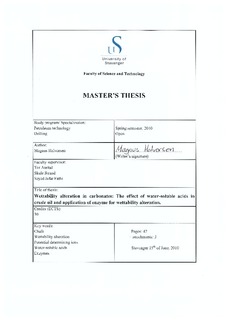| dc.contributor.author | Halvorsen, Magnus | |
| dc.date.accessioned | 2011-01-03T10:02:37Z | |
| dc.date.available | 2011-01-03T10:02:37Z | |
| dc.date.issued | 2010 | |
| dc.identifier.uri | http://hdl.handle.net/11250/183297 | |
| dc.description | Master's thesis in Petroleum engineering | en_US |
| dc.description.abstract | The objective of the project is defined in two phases. The first phase is to study the effect of
oil composition and carboxylic acids in the crude oil on the wetting condition and wettability
alteration process using “Smart Water”. It has been reported that the major types of acidic
compounds in crude oil were identified as carboxylic acids, phenols, carbazoles, and amides.
The phenols and carboxylic acids comprise the major portion of the acidic species. The water
soluble components of the carboxylic material are a small fraction of the total amount of
carboxylic acids in the crude oil. They play an important role in establishing the initial
wetting condition by contributing to destabilize the water film between the rock and oil.
In this work, we have extracted water-soluble acids from a crude oil with high acid number
(AN) to study the effect of these acidic materials on the wetting condition. Two crude oils
have been prepared with almost the same acid number: the original oil, RES40 and synthetic
crude oil containing only water-soluble acids termed EWS-oil. Two parallel cores were
saturated and aged with each crude oil. The cores were subjected to spontaneous imbibition to
study the oil displacement efficiency by “Smart Water”. The potentiality of seawater as a
wettability modifier has been investigated previously. The mechanism of wettability alteration
has been proposed based on the interactions between the rock surface and the potential
determining ions Ca2+, Mg2+ and SO4
2- present in seawater.
It was concluded that, not only the strength of the bonding of carboxylic material onto the
calcite surface dictated by the carboxylic group, AN, is an important wetting parameter; but
also the organic structure of the carboxylic material may have an impact on the wetting
condition as well.
The second phase of the project is to study the application of Enzymes to improve the wetting
condition towards water-wetness. An enzyme-based method has already been reported, which
generates organic acids for a variety of acidizing applications such as a matrix acidizing, the
stimulation of natural fracture networks, damage removal over long horizontal intervals. The
generation of acid in-situ following placement of the fluid ensures the even delivery of acid
over the whole of the treated zone.
Two cores were saturated and aged with the crude oil, RES40. After forced displacement with
seawater depleted in sulfate and establishing residual oil saturation, the enzyme solution was
injected into the cores and shut-in for 48 or 96 hours in an attempt to improve the wetting
condition towards water-wetness. Later, the chromatographic wettability test was performed
to monitor the change in the wetting condition. No improvement in the wetting condition and
displacement efficiency was observed after enzyme injection. | en_US |
| dc.language.iso | eng | en_US |
| dc.publisher | University of Stavanger, Norway | en_US |
| dc.relation.ispartofseries | Masteroppgave/UIS-TN-IPT/2010; | |
| dc.subject | petroleumsteknologi | en_US |
| dc.subject | chalk | en_US |
| dc.subject | wettability alteration | en_US |
| dc.subject | potential determining ions | en_US |
| dc.subject | water-soluble acids | en_US |
| dc.subject | enzymes | en_US |
| dc.title | Wettability alteration in carbonates : the effect of water-soluble acids in crude oil and application of enzyme for wettability alteration | en_US |
| dc.type | Master thesis | en_US |
| dc.subject.nsi | VDP::Technology: 500::Rock and petroleum disciplines: 510 | en_US |
| dc.source.pagenumber | 49 p. | en_US |
